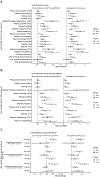Epigenetic Biomarkers of Prenatal Tobacco Smoke Exposure Are Associated with Gene Deletions in Childhood Acute Lymphoblastic Leukemia
- PMID: 34020997
- PMCID: PMC8338876
- DOI: 10.1158/1055-9965.EPI-21-0009
Epigenetic Biomarkers of Prenatal Tobacco Smoke Exposure Are Associated with Gene Deletions in Childhood Acute Lymphoblastic Leukemia
Abstract
Background: Parental smoking is implicated in the etiology of acute lymphoblastic leukemia (ALL), the most common childhood cancer. We recently reported an association between an epigenetic biomarker of early-life tobacco smoke exposure at the AHRR gene and increased frequency of somatic gene deletions among ALL cases.
Methods: Here, we further assess this association using two epigenetic biomarkers for maternal smoking during pregnancy-DNA methylation at AHRR CpG cg05575921 and a recently established polyepigenetic smoking score-in an expanded set of 482 B-cell ALL (B-ALL) cases in the California Childhood Leukemia Study with available Illumina 450K or MethylationEPIC array data. Multivariable Poisson regression models were used to test the associations between the epigenetic biomarkers and gene deletion numbers.
Results: We found an association between DNA methylation at AHRR CpG cg05575921 and deletion number among 284 childhood B-ALL cases with MethylationEPIC array data, with a ratio of means (RM) of 1.31 [95% confidence interval (CI), 1.02-1.69] for each 0.1 β value reduction in DNA methylation, an effect size similar to our previous report in an independent set of 198 B-ALL cases with 450K array data [meta-analysis summary RM (sRM) = 1.32; 95% CI, 1.10-1.57]. The polyepigenetic smoking score was positively associated with gene deletion frequency among all 482 B-ALL cases (sRM = 1.31 for each 4-unit increase in score; 95% CI, 1.09-1.57).
Conclusions: We provide further evidence that prenatal tobacco-smoke exposure may influence the generation of somatic copy-number deletions in childhood B-ALL.
Impact: Analyses of deletion breakpoint sequences are required to further understand the mutagenic effects of tobacco smoke in childhood ALL.
©2021 American Association for Cancer Research.
Conflict of interest statement
Figures



Similar articles
-
Correlates of Prenatal and Early-Life Tobacco Smoke Exposure and Frequency of Common Gene Deletions in Childhood Acute Lymphoblastic Leukemia.Cancer Res. 2017 Apr 1;77(7):1674-1683. doi: 10.1158/0008-5472.CAN-16-2571. Epub 2017 Feb 15. Cancer Res. 2017. PMID: 28202519 Free PMC article.
-
450K epigenome-wide scan identifies differential DNA methylation in newborns related to maternal smoking during pregnancy.Environ Health Perspect. 2012 Oct;120(10):1425-31. doi: 10.1289/ehp.1205412. Epub 2012 Jul 31. Environ Health Perspect. 2012. PMID: 22851337 Free PMC article.
-
Gene-Environment Analyses Reveal Novel Genetic Candidates with Prenatal Tobacco Exposure in Relation to Risk for Childhood Acute Lymphoblastic Leukemia.Cancer Epidemiol Biomarkers Prev. 2023 Dec 1;32(12):1707-1715. doi: 10.1158/1055-9965.EPI-23-0258. Cancer Epidemiol Biomarkers Prev. 2023. PMID: 37773025 Free PMC article.
-
Tobacco smoke exposure and the risk of childhood acute lymphoblastic leukemia and acute myeloid leukemia: A meta-analysis.Medicine (Baltimore). 2019 Jul;98(28):e16454. doi: 10.1097/MD.0000000000016454. Medicine (Baltimore). 2019. PMID: 31305478 Free PMC article.
-
DNA methylation as a potential mediator of environmental risks in the development of childhood acute lymphoblastic leukemia.Epigenomics. 2016 Apr;8(4):519-36. doi: 10.2217/epi-2015-0011. Epub 2016 Apr 1. Epigenomics. 2016. PMID: 27035209 Free PMC article. Review.
Cited by
-
Environmental Pollution and Risk of Childhood Cancer: A Scoping Review of Evidence from the Last Decade.Int J Mol Sci. 2024 Mar 14;25(6):3284. doi: 10.3390/ijms25063284. Int J Mol Sci. 2024. PMID: 38542255 Free PMC article.
-
Investigating DNA methylation as a mediator of genetic risk in childhood acute lymphoblastic leukemia.Hum Mol Genet. 2022 Oct 28;31(21):3741-3756. doi: 10.1093/hmg/ddac137. Hum Mol Genet. 2022. PMID: 35717575 Free PMC article.
-
Pre- and Postnatal Exposures to Tobacco Smoking and Survival of Childhood Acute Lymphoblastic and Myeloid Leukemias in California, United States.Cancer Epidemiol Biomarkers Prev. 2024 Jan 9;33(1):117-125. doi: 10.1158/1055-9965.EPI-23-0801. Cancer Epidemiol Biomarkers Prev. 2024. PMID: 37921440 Free PMC article.
-
miR-4716-3p and the target AKT2 Gene/rs2304186 SNP are associated with blood cancer pathogenesis in Pakistani population.Noncoding RNA Res. 2024 Mar 14;9(3):695-703. doi: 10.1016/j.ncrna.2024.03.005. eCollection 2024 Sep. Noncoding RNA Res. 2024. PMID: 38577021 Free PMC article.
-
The Influence of DNA Repair Genes and Prenatal Tobacco Exposure on Risk of Childhood Acute Lymphoblastic Leukemia: A Gene-Environment Interaction Study.Cancer Epidemiol Biomarkers Prev. 2025 Jan 9;34(1):100-107. doi: 10.1158/1055-9965.EPI-24-1037. Cancer Epidemiol Biomarkers Prev. 2025. PMID: 39495115 Free PMC article.
References
-
- Ward E, DeSantis C, Robbins A, Kohler B & Jemal A Childhood and adolescent cancer statistics, 2014. CA: A Cancer Journal for Clinicians 64, 83–103 (2014). - PubMed
-
- Cancer Facts & Figures. American Cancer Society; (2020).
-
- Winther JF & Schmiegelow K How safe is a standard-risk child with ALL? The Lancet Oncology 15, 782–783 (2014). - PubMed
Publication types
MeSH terms
Substances
Grants and funding
LinkOut - more resources
Full Text Sources
Other Literature Sources
Medical

